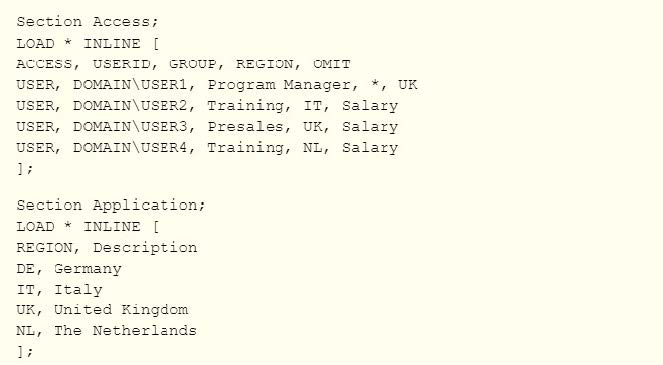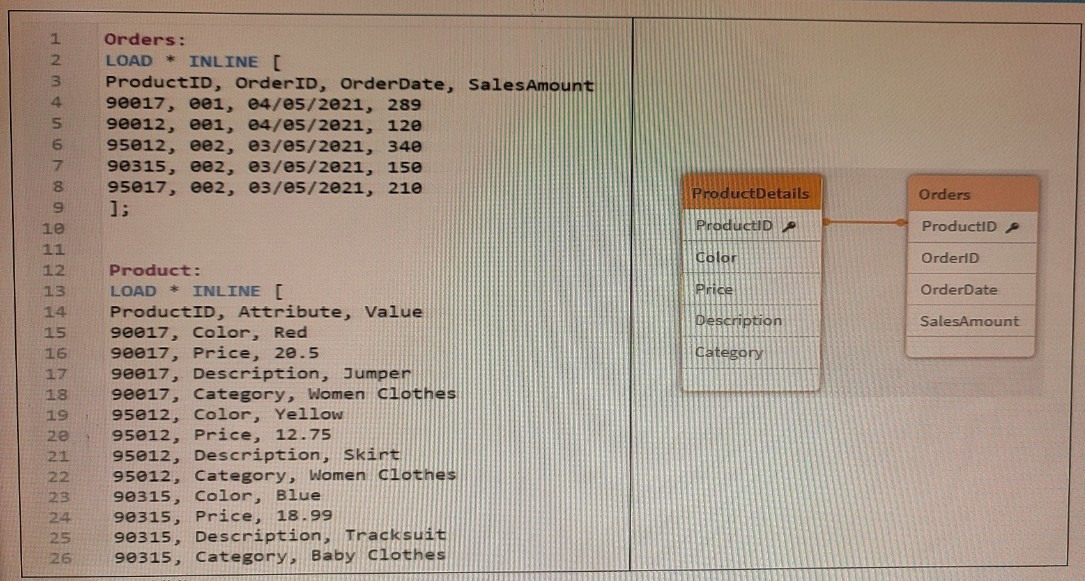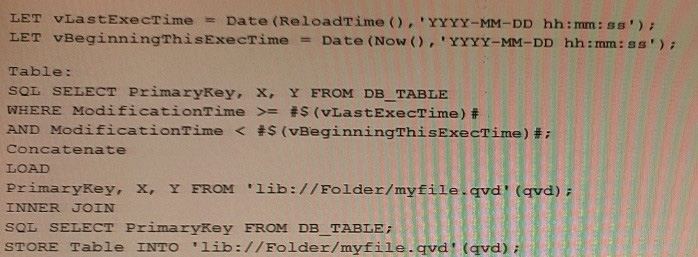Exam Details
Exam Code
:QSDA2022Exam Name
:Qlik Sense Data Architect Certification - 2022Certification
:QlikView CertificationsVendor
:QlikViewTotal Questions
:77 Q&AsLast Updated
:Jun 06, 2025
QlikView QlikView Certifications QSDA2022 Questions & Answers
-
Question 21:
A data architect needs to write the expression for a measure on a KPI to show the sales person with the highest sales The sort order of the values of the fields is unknown When two or more sales people have sold the same amount, the expression should return all of those sales people
Which expression should the data architect use?
A. FirstSortedValue (Salesperson, -Aggr (Sum(Sales) , Salesperson) )
B. Concat(DISTINCT IF (Aggr (Rank (Sum (Sales) , 4) , Salesperson) =1, Salesperson) , ' ')
C. FirstSortedValue (DISTINCT Salesperson, -Aggr (Sum(Sales) , Salesperson) )
D. Concat (DISTINCT IF (Aggr (Rank (Sum (Sales) , 1) , Salesperson) =1, Salesperson) , ' ')
-
Question 22:
A data architect needs to arrange data to create an app with a map where multiple location points consolidate into hexagonal areas based on postal codes
The areas will be color coded based on the number of vendors in the location.
Which GeoAnalytics operation should the data architect use?
A. Binning
B. Intersect
C. AddressLookup
D. Simplify
-
Question 23:
A data architect is building a model to show trends in visualizations across seven date fields. The seven date fields reside in different tables. The data architect must efficiently build this data model.
Requirements:
A single date selector
Show all dates, even those with NO activity
Minimize the impact on server resources and p
Which two solutions should the data architect use? (Select two.)
A. Canonical calendar
B. Generic load
C. Data island
D. Multiple calendars
E. Link table
-
Question 24:
Refer to the exhibit.

USER1 has an app protected using this Section Access statement. Which countries can USER1 see in the app''
A. Germany. Italy, United Kingdom, The Netherlands
B. Italy, The Netherlands
C. Italy, United Kingdom, The Netherlands
D. Germany Italy, The Netherlands
-
Question 25:

Refer to the exhibit.
A data architect is loading two tables: Orders and Product. The Product table includes attributes and values for each ProductID such as Colour, Price, Category, and Description.
The business analyst can filter by the value of these attributes. For performance reasons, the Data Model will use two tables.
Which solution should the data architect apply in the Data Load Editor to build the ProductDetails table?
For performance reasons, the Data Model will use two tables a Load Editor to build the ProductDetails table?
A. Use a For loop to concatenate all of the Products table and apply a Generic Load to the final concatenate table
B. Use a For loop to apply a Generic load to the Product table and concatenate the generic tables together
C. Use a Generic Load in the Product table and a For loop to left join each Generic table
-
Question 26:
Refer to the exhibit.

Which changes on the database will the script capture?
A. Insert and Remove rows
B. Insert. Update, and Remove rows
C. Insert and Update rows
D. Update and Remove rows
-
Question 27:
A data architect needs to efficiently prepare a data model for a meeting in an hour.
The data source to be used contains five date fields The app needs to display sales trends and compare the current year to date (CYTD) to last year to date (LYTD) The app is NOT going to be published It will only be used for this meeting
and a single user's ad-hoc analysis.
What should the data architect do to meet these requirements?
A. Use the data manager
B. Load a calendar island
C. Create a canonical calendar
D. Create five master calendars
-
Question 28:
A data architect is using an Include statement to load the collection of variables from a TextFiles folder connection into an app. The data architect needs to load the data and generate an error if it fails. Which statement should the data architect use?
A. $
B. $(Must_Include=lib://TextFiles/Variables.txt);
C. (Must_Include=lib://TextFiies/Variables.txt);
D. (Includs=lib://TextFiles/Variables.txt);
-
Question 29:

Refer to the exhibits.
The first table shows the source table (Original table).
This data represents the stocks stored every month for each product:
The relevant fields are productid, qty, and date.
The date field represents the calendar months using
The qty field shows the product stock fluctuation from the current month versus the previous month. If there is no fluctuation between months, there are no new entries in the table.
The second table shows a Pivot table visualization the data analyst needs to create in the app displaying per each product the monthly trend of available stock.
For performance reasons, the data analyst requests the data architect to calculate the running stock quantity of each product for every month in the script.
Which approach should the data architect use?
A. 1. Generate a Cartesian JOIN between productid and date in a Combined table
2.
RIGHT JOIN the Combined table with the Original table to populate the missing qty values
3.
Use PREVIOUS() and RANGESUMQ functions to create the running quantity totals for each product for every month
B. 1. Generate a Cartesian JOIN between productid and date in a Combined table
2.
LEFT JOIN the Combined table with the Original table to populate the missing qty values
3.
Use PREVIOUSO and SUM() functions to create the running quantity totals for each product for every month
C. 1. Generate a Calendar table with all dates between the minimum and maximum date values in an Original table
2.
RIGHT JOIN the Calendar table back to the Original table to populate the missing qty values
3.
Use PEEK() and RANGECOUNTO functions to create the running quantity totals for each product for every month
D. 1 Generate a Calendar table with all dates between the minimum and maximum date values in an Original table
2. LEFT JOIN the Calendar table back to the Original table to populate the missing qty values
-
Question 30:

Refer to the exhibits.
An app is built to analyze salesperson performance by department. Departments are unique within the Departments table, but Salespeople often move between departments. A strict business rule states that a salesperson must be associated
with ONLY one department at all times.
The data architect creates a summary of department performance and notices the values are incorrect. The total sales KPI shows the correct result.
How should the data architect modify the data model to correct this issue?
A. Create a bridge table between the Departments and Salespeople tables to resolve the many-to-many relationship
B. Create a bridge table between the Transactions and Salespeople tables to resolve the many-to-many relationship
C. Join the Departments and Salespeople tables to resolve the many-to-many relationship
D. Join the Transactions and Salespeople tables to resolve the many-to-many relationship
Related Exams:
QREP
Qlik Replicate CertificationQSBA2021
Qlik Sense Business Analyst Certification - February 2021 ReleaseQSBA2024
Qlik Sense Business Analyst Certification - 2024QSDA2018
Qlik Sense Data Architect Certification - June 2018 ReleaseQSDA2019
Qlik Sense Data Architect Certification - June 2019 ReleaseQSDA2021
Qlik Sense Data Architect Certification - February 2021 ReleaseQSDA2022
Qlik Sense Data Architect Certification - 2022QSDA2024
Qlik Sense Data Architect Certification - 2024QSSA2018
Qlik Sense System Administrator Certification - June 2018 ReleaseQV_DEVELOPER_01
QlikView 11 Developer Certification
Tips on How to Prepare for the Exams
Nowadays, the certification exams become more and more important and required by more and more enterprises when applying for a job. But how to prepare for the exam effectively? How to prepare for the exam in a short time with less efforts? How to get a ideal result and how to find the most reliable resources? Here on Vcedump.com, you will find all the answers. Vcedump.com provide not only QlikView exam questions, answers and explanations but also complete assistance on your exam preparation and certification application. If you are confused on your QSDA2022 exam preparations and QlikView certification application, do not hesitate to visit our Vcedump.com to find your solutions here.